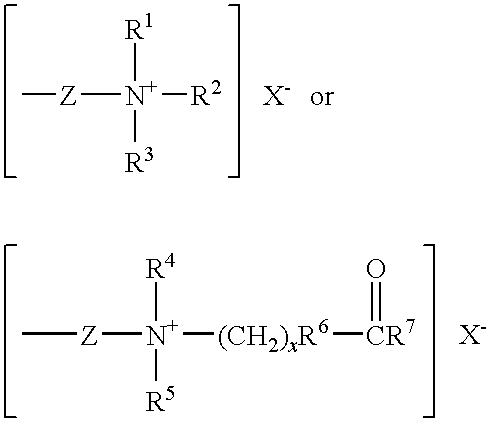Method for making particulate slurries and particulate slurry compositions
a technology of slurry composition and particulate slur, which is applied in the field of aqueous slurry composition, can solve the problems of insufficient hydrophobicity of such compounds, more difficult for proppants to be carried away by fluid, etc., and achieves the effects of easy dewatering, high conductivity, and large porosity
- Summary
- Abstract
- Description
- Claims
- Application Information
AI Technical Summary
Benefits of technology
Problems solved by technology
Method used
Image
Examples
example 1
[0035]50 ml of water and 50 grams of 20 / 40 mesh fracturing sands were added into each of two glass bottles (200 ml). 0.5 ml of Tegopren 6923, a di-quaternary ploysiloxane from Degussa Corp., was added into one of the bottles and the other bottle was used as control. The bottles were vigorously shaken and then let stand to allow sands settle down. The volumes of the settled sands in the two bottles were compared. In the bottle containing Tegopren 6923, the volume of the settled sands was about 40 percent greater than the one without. When the bottles were tilted, the settled sands in the bottle with straight water fended to move as individual sand grains, while the settled sands containing Tegopren 6923 tended to move as cohesive masses.
example 2
[0036]50 ml water, 50 grams of 20 / 40 mesh fracturing sands, 0.5 ml of Tegopren 6923 and 0.01 ml of Aquard 18-50, a hydrocarbon quaternary ammonium salt from Akzo Nobel Corp., was mixed into a glass bottle (200 ml). The bottles were vigorously shaken and then let stand to allow sands settle down. The sand grains immediately following agitation were fully distributed in water making stable slurry. After one hour, about half amount of sands settled down to the bottom while the other half was floating on the top.
example 3
[0037]100 ml of water and 50 grams of 20 / 40 mesh ceramic proppants were added into each of two glass bottles (200 ml). 0.5 ml of TEGO Betaine 810, a capryl / capramidopropyl betaine from Degussa Corp., and 1 ml of a solution containing 20% Tegopren 6924, a di-quaternary ploysiloxane from Degussa Corp., and 80% of ethylene glycol mono-butyl ether were added into one of the bottles, and the other bottle was used as control. The bottles were vigorously shaken and then let stand to allow proppants settle down. In the one containing Tegopren 6924 about 25% of proppants was floating on the top and the remaining 75% settled on the bottom. The volume of the 75% settled proppants was still significantly larger than the control one. When the bottles were tilted, the settled proppants in the bottle with straight water tended to move as individual grains, while the settled proppants containing Tegopren 6924 tended to move as cohesive masses.
PUM
| Property | Measurement | Unit |
|---|---|---|
| density | aaaaa | aaaaa |
| density | aaaaa | aaaaa |
| contact angle | aaaaa | aaaaa |
Abstract
Description
Claims
Application Information
 Login to View More
Login to View More - R&D
- Intellectual Property
- Life Sciences
- Materials
- Tech Scout
- Unparalleled Data Quality
- Higher Quality Content
- 60% Fewer Hallucinations
Browse by: Latest US Patents, China's latest patents, Technical Efficacy Thesaurus, Application Domain, Technology Topic, Popular Technical Reports.
© 2025 PatSnap. All rights reserved.Legal|Privacy policy|Modern Slavery Act Transparency Statement|Sitemap|About US| Contact US: help@patsnap.com



